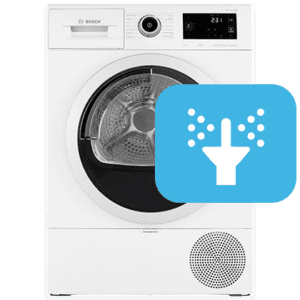What is a self-cleaning heat pump dryer
A self-cleaning heat pump dryer is an ideal solution when you don’t want to keep track of when the condenser needs to be cleaned or if you regularly forget. Keeping the heat pump dryer clean is very important, for function, energy consumption and safety. A self-cleaning heat pump dryer that does this is very convenient. Then you don’t have to worry about it anymore. But how much does a self-cleaning heat pump dryer cost? And what else can you look out for when buying a new heat pump dryer?
In this category, too, some heat pump dryers are better than others. For example, a better quality and longer life, a more user-friendly operation, more drying programs or a more favorable energy label. However, the price logically increases with the increase in function. All in all, there is therefore one final yardstick we use to choose the best self-cleaning heat pump dryer: the best value for money.
Best self-cleaning heat pump dryer by 2024
When you want a heat pump dryer that cleans itself you look for the best in its class. To make sure you’re buying the best self-cleaning dryer from 2024, we’ve made a unique selection for you. This overview is based on the price-quality ratio, the drying performance and for now one of the most important features: how well the heat pump dryer cleans itself.
Advantages of a self-cleaning heat pump dryer
A self-cleaning heat pump dryer has a self-cleaning condenser. The advantages are obviously that you don’t have to clean the condenser yourself. The heat pump dryer detects when it is needed and does it for you, which is very convenient. In addition, this is also beneficial for the energy consumption and lifetime of the heat pump dryer. A heat pump dryer with a dirty condenser is less efficient, takes longer to run and uses more energy per drying cycle. The advantages are obvious: you don’t have to clean the condenser yourself. The heat pump dryer detects when it is needed and does it for you, which is very convenient. In addition, this is also beneficial for the energy consumption and lifetime of the heat pump dryer. A heat pump dryer with a dirty condenser is less efficient, takes longer to run and uses more energy per drying cycle. There are actually no disadvantages. The only disadvantage is that the purchase price is on average a bit higher than a heat pump dryer that does not have this feature. But on the other hand, the quality, durability and energy label of this heat pump dryer is also more favourable
All in all, this results in lower annual energy costs and a longer lifespan. The difference in purchase price will certainly be earned back, which is nice!
What to look out for when buying a self-cleaning heat pump dryer
That you want a self-cleaning heat pump dryer is one step, but do you know what other things you look for in a heat pump dryer? What’s important to you may not be important to someone else. However, it’s worth thinking about a few things so that you can decide what you want from it. The energy label determines how much the heat pump dryer will cost in the coming years. A cheap heat pump dryer with a less favorable energy label will eventually become more expensive. It’s a shame not to take this into account. A more favourable energy label can save hundreds of euros over the lifetime of the heat pump dryer. The features that a heat pump dryer has to offer vary. Available features with a self-cleaning heat pump dryer include an allergy program, sensors that measure the moisture of the laundry, and automatic dosing of a fragrance.
Maximum noise level
A self-cleaning heat pump dryer also comes in the quiet version. This is handy when you want to turn it on at night or if the heat pump dryer is in a place where you can hear it clearly. For this, choose a heat pump dryer with a maximum noise level of 64 dB.
Fill weight
The fill weight ranges from 7 to 9 kilograms. For a household of one to two people, 7 kilograms is sufficient. If you have a household of three to four people, 8 kilograms is suitable, and with a household of more than five people, a 9 kilogram fill weight is better. It’s definitely worth taking this into account. A suitable load prevents overloaded or empty driers and saves on unnecessary wash cycles. This results in a lower energy bill and a more environmentally friendly use of the heat pump dryer. In addition, the lifespan also depends on the frequency with which the heat pump dryer is used. If the dryer is working overtime because the fill weight is actually too small for the household, the heat pump dryer will not last as long.
Building quality
The build quality is important to the lifespan of the heat pump dryer, but also to its environmental friendliness. The better the build quality, the longer the life and the more environmentally friendly the heat pump dryer is. We do not recommend choosing a basic class of build quality. These models use less durable materials and are more susceptible to wear and tear. The build quality depends on the materials used, the amount of parts in the motor and whether or not it has a self-cleaning condenser. Within the selection of self-cleaning heat pump dryers, there are almost no models with a basic build quality, which is nice! If your budget allows it, go for a top class build quality. This is no guarantee of a long life, but the chances of a heat pump dryer shutting down prematurely are considerably lower.
Model
The model can also be a deciding factor in some situations, for example, a particular direction of the door or a reversible door can be useful. You may also need a smaller model because the heat pump dryer needs to fit into a niche or under a countertop. When stacking a heat pump dryer and a washing machine, it is also useful to check whether the sizes match. Finally, there are both glass and solid doors, depending on your own preference.

